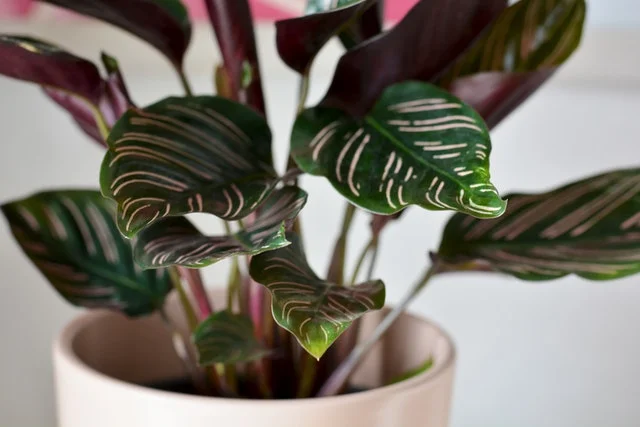Table of Contents
How to Care for Calathea Roseopicta
The Calathea Roseopicta is a tropical plant species with large leaves. These plants have vibrant leaves. Calathea Roseopicta plants do not grow very tall and they do not mature quickly.
They tend to reach a height of fifty centimeters and the plants tend to grow wider rather than taller. These plants are natively found in South American rainforests.
What Does Your Calathea Roseopicta Require
Light Requirements
These plants require a reasonable amount of light. Calathea Roseopicta will do best when they are placed in indirect sunlight in rooms that are east, west, or north facing.
These plants need to be kept out of direct sunlight, as it can burn the leaves and cause the plant to become dull. Although these plants do not like direct sunlight, they do not do well in areas that are too dark.
Temperature Requirements
As this is a tropical plant it does not thrive in cold temperatures. Calathea Roseopicta plants are best kept at temperatures between eighteen and twenty-four degrees centigrade.
Temperature will not become an issue for the plant until it is colder than fifteen degrees centigrade.
It is important to avoid sudden temperature changes for Calathea Roseopicta plants, as they do not adjust well to sudden changes.
Soil Requirements
Calathea Roseopicta plants require a moist soil. A peat-based soil is best for these plants and it is important that the plant has suitable drainage.
These plants require a soil that is well drained and able to quickly drain off excess moisture whilst retaining the water.
Humidity Requirements
Calathea Roseopicta plants require a high level of humidity and this can be reached by regularly misting the plants. These are good plants to keep in the bathroom or kitchen as it’s easier to get a high level of humidity.
These plants are suitable for keeping in a terrarium or aquarium as these will help to keep the moisture in and keep the plant in suitable conditions.
How to Water Calathea Roseopicta
Calathea Roseopicta plants prefer to be in areas that have a constant level of moisture, but they need to avoid overwatering. A regular spray of misting is the best way to water these plants.
Checking the leaves of the plant will inform if the plant has enough water. If the leaves are curling inwards, then add more water to the plant and for leaves that become droopy do not add any moisture.
How to Fertilise Calathea Roseopicta
Calathea Roseopicta plants will benefit from the addition of fertiliser during the spring and summer months. These plants will not require any fertiliser during the autumn and winter months.
Extra Tips for Calathea Roseopicta
Pests and Diseases
Calathea Roseopicta plants tend to be resistant to diseases and pests. These plants require some specific living conditions and problems can arise if these are not met.
When moisture is involved the problem of diseases and pests is not too far away due to it attracting fungus and bacteria.
There are several pests that are attracted to the large leaves on these plants. One of the most common pests that affects these plants are spider mites.
Regularly check the plants for any changes as they can be affected by too much or too little water and the leaves will show signs of distress.
Pruning
Pruning is a very important part of looking after these plants. Only a sharp knife or scissors are required for pruning these plants. These plants should get pruned at the start of the growth period so that they can use energy to germinate healthy leaves and stems.
Calathea Roseopicta plants should be trimmed when any signs of decay are spotted as this will affect the growth of the plant.
Brown corners on the leaves of these plants should be trimmed using sharp scissors and when trimming follow the shape of the leaf. After trimming the leaves should begin to grow again.
Blooms that are faded should be pruned to avoid them taking too much energy from the other sections of the plant.
- Ensure that you are using a sharp tool so that you do not cause damage to the plant.
- Remove the leaves from the base at the point where they join to the stem when cutting, however leave the node so that new growth can germinate.
Propagation
Calathea Roseopicta can be propagated during repotting season. Propagation is an easy process through the trimming of separate sections using a knife.
Propagation from Divided Plants
This is a very easy process to complete. Check the pots for overcrowding and when they are struggling for space then they can be used for new plants.
- Gently spread the stems using your hands so that there is space between the stems. Pat the soil down in the pot.
- Once the stems are separated put a sheet of paper on a flat surface. Turn the plant pot upside down so that earth and plant come out onto the paper.
- Carefully separate the roots from the plant ensuring that each stem has at least one root and one leaf, as the plant will not be able to develop new growth without this.
- Use several small pots for the newly divided plants. Take some of the soil mixture from the parent pot for using in the small pots.
- Ensure that the new plants are correctly saturated and keep them out of direct sunlight. These plants should be kept in an area where the temperature is steady and there are no fluctuations.
- Cover the new plants with plastic to give them additional moisture. This is especially good for plants that are in a drier environment.
Re-Potting Calathea Roseopicta
When potting these plans, it is important to choose a plant pot that will allow the plant to mature and grow. The most suitable pots will need to allow for drainage so that they do not become oversaturated.
Repotting is a very easy process and it only needs to be completely done every two to three years. It can be a good idea to have these plants in a pot that is slightly larger than it needs especially during the spring months.
These plants do not like to be rootbound therefore they need to be re-potted every couple of years.
It is easy to check if the plant needs to be moved to a bigger pot by spreading the soil and checking the roots of plant. If the roots appear to be taking up too much space, then the plant will need to be moved to a pot that is slightly bigger.
Avoid choosing a plant pot that is too big, its best to choose one that is only slightly bigger than the previous one.
FAQ
How Do You Care for Calathea Roseopicta?
Take time to get the correct soil for the plants, as they will thrive in a potting mix that is peat-based. It is best to use a mix that is one-part perlite to two parts peat.
Temperature is an important factor for this plant. Avoid keeping these plants in an area that has a cold temperature or a temperature that fluctuates. It is best to keep these plants in a temperature between eighteen and twenty-four degree centigrade.
Misting of these plants will provide them with enough water and give the plants a high level of humidity. Keep on top of the repotting and propagation of these plants to prevent them becoming overcrowded.
Is Calathea Roseopicta Good for Indoors?
Calathea Roseopicta plants prefer to be kept indoors and this makes it easier to meet the demanding factors in terms of light and humidity.
When kept indoors these plants are best kept on a window sill where it can get plenty of light during the day however avoid putting it in an area where it can get draughts.
How Often Should I Water Calathea Roseopicta?
It can be difficult to get the correct level of watering for Calathea Roseopicta plants. During the spring and summer months a little bit of watering a couple of times a week should be enough.
Keep an eye on the soil and ensuring that it doesn’t become too dry. To check the level of moisture in the soil push a finger into the soil.
During the autumn and winter months the amount of watering can be reduced, although never let the soil completely dry out.
Can Calathea Roseopicta Grow in Low Light?
Calathea Roseopicta plants do not do well in low light conditions. These plants thrive in conditions with bright light but not direct sunlight. Direct sunlight should be avoided as this can burn the leaves.
Limp Stems on Calathea Roseopicta
If the stems of the Calathea Roseopicta plants are looking limp then check the moisture of the soil and the temperature that the plant is in, as these can both cause this problem.
Check the soil and see if the roots are soggy. If the plants are too soggy then repot them in soil that is drier. If the temperature is the problem, then move the plant to a warmer room.
Photo by Nina Pintar from Pexels



